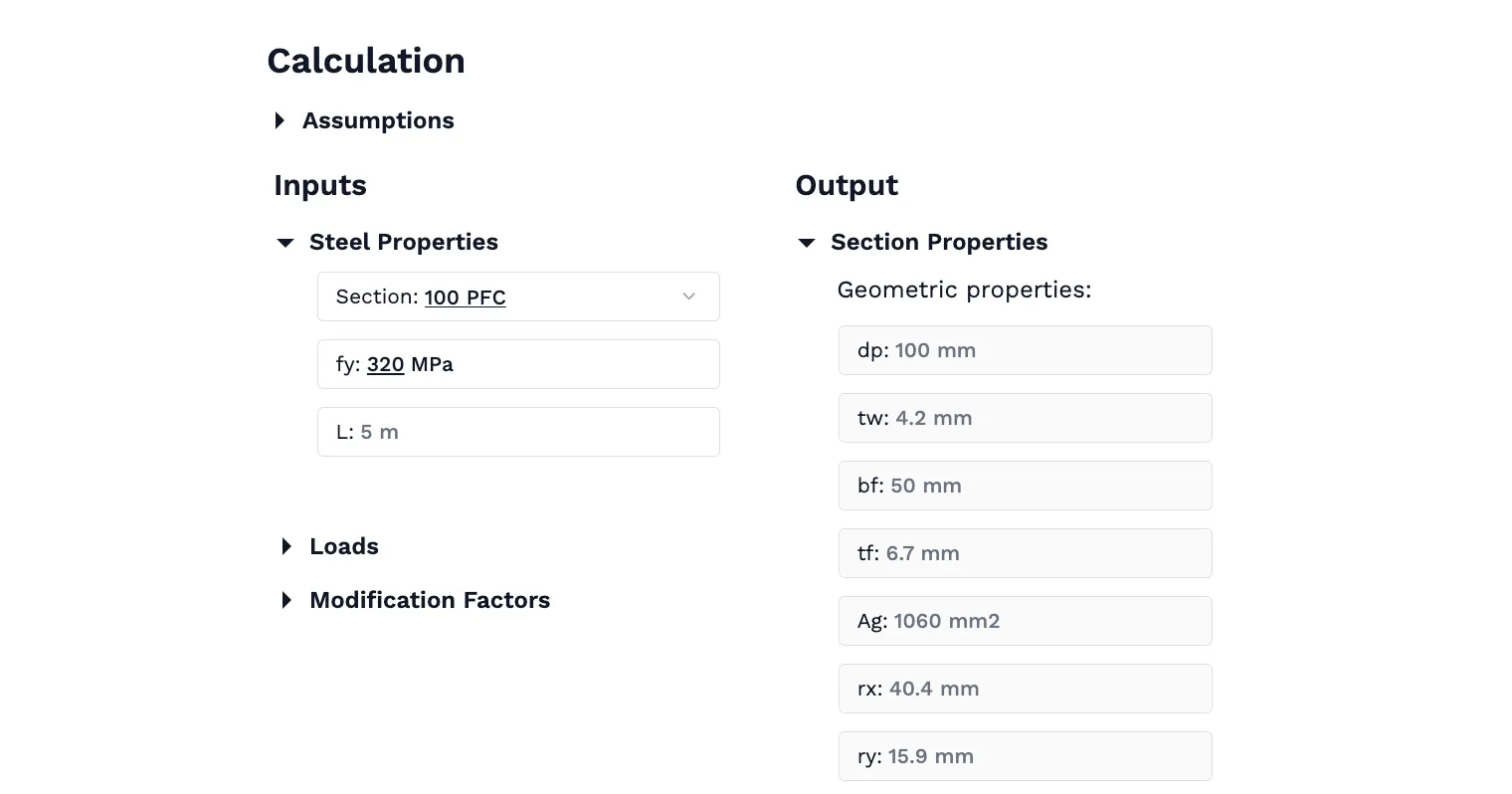Free Steel Member Design Tool to AS 4100. Step-by-step, engineering-grade tool with downloadable report.

This template is not available yet. You can sign up and create it yourself!
Or let us know if you'd like to be notified when it’s ready:
About this Steel Member Design to AS 4100 Calculator
Steel member design to AS 4100 is the foundation of safe and efficient steel structures across Australia. This tool helps you design standard steel sections by calculating their flexural and axial design capacities. It ensures compliance with the Ultimate Limit State (ULS) methods as specified in AS 4100-2020, offering precise and reliable calculations for steel members in structural applications. Ideal for:
- Structural engineers: Verify beams, columns, and connections with confidence, reducing manual calculations and improving design accuracy.
- Design consultants: Compare steel sections and optimise layouts for weight, capacity, and material use.
- Construction professionals: Validate on-site member sizing against original specifications and design standards.
Built to handle axial loads, bending moments, and shear capacity checks, this calculator is an engineering-grade tool for professionals seeking precision.
For a useful guide on steel design, see our Steel Design Rules of Thumb for Structural Engineers.
Introduction to Steel Member Design to AS 4100 Calculations
Understanding Steel Members and Sections
Steel members include beams, columns, and bracing elements that form the skeleton of steel structures. Each member’s role determines the forces it must resist—compression in columns, bending in beams, or a combination of loads. Selecting the correct steel sections and ensuring they meet section capacity requirements is the first step in the design process.
Key Considerations in Member Design
Designing to AS 4100 involves more than just picking a steel grade. Engineers must factor in lateral restraints, flange restraints, and the member’s slenderness. Calculations need to address loading conditions and forces along the principal axes to prevent issues like lateral torsional buckling or failure under combined loads.
The Ultimate Limit State Approach
The ultimate limit state (ULS) framework ensures that members have adequate structural capacity to withstand extreme loads without collapse. It covers tension, compression, shear, and bending, ensuring each steel element performs safely under its design loads. This method balances safety factors, material properties, and connection details to keep designs within code.
Bending Moments, Axial Loads, and Shear
Steel beams often face bending moments and shear forces, while columns carry axial loads and sometimes additional bending. Steel member design must account for these combined effects, verifying moment capacity, shear capacity, and section capacity under the specified loading conditions.
For more information on steel design, check out our Steel Design Rules of Thumb for Structural Engineers.
Common Calculation Errors to Avoid
- Incorrect load combinations can result in members being under-designed, leading to inadequate structural capacity.
- Neglecting lateral restraints may cause lateral torsional buckling, even if the member seems strong in linear analysis.
- Using the wrong steel grade can create unsafe assumptions about strength and stiffness.
- Overlooking connection details means the calculated member capacity may not reflect real-world behaviour.
- Failing to check section compactness could lead to unexpected local flange buckling under compression.
- Assuming a uniform shape response when members with non-compact cross sections behave differently under bending and axial loads.
Engineering templates
Common calculators
Design guides
FAQs
What is the purpose of AS 4100 in steel member design?
AS 4100 is the Australian standard that governs the design of steel structures. It sets out requirements for beams, columns, and connections, ensuring members meet ultimate limit state and serviceability requirements.
How do axial loads and bending moments interact in member design?
Members often face combined loading. A column, for example, may carry axial loads while experiencing bending from eccentric connections. Steel member design to AS 4100 uses interaction formulas to confirm combined capacity.
What factors affect the moment capacity of a steel beam?
Moment capacity depends on section shape, steel grade, lateral restraints, flange restraints, and the effective length. These factors are checked against design standards to ensure safety.
Can this calculator handle both beams and columns?
Yes. It can check steel beams for bending and shear, columns for compression and buckling, and even members with combined loading conditions, all in accordance with AS 4100.
Summary and References
Steel member design to AS 4100 requires understanding how beams, columns, and other members behave under loads. By considering key factors like lateral restraints, ultimate limit state requirements, and connection details, engineers can achieve accurate, safe, and efficient designs.
For more calculators and resource, see further below. Reference:
- Standards Australia’s AS 4100 – Steel Structures
Learn about the benefits of using CalcTree on engineering projects!




